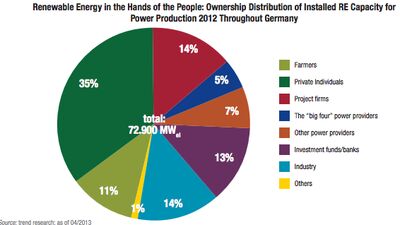It’s easy to declare Germany’s ambitious policy of moving to clean energy from fossil fuels, while at the same time abandoning nuclear power, a failure. After all, the country burns more coal than five years ago, has some of the highest household electricity bills in the developed world and will miss its 2020 greenhouse gas emission targets.
To me, though, the policy’s results show how a determined government can eventually shake up complacent oligopolies and point their thinking in a different direction. 
The German government’s subsidies to wind, solar and other renewable energy producers have grown to 20 billion euros a year (almost $26 billion at the current exchange rate) since 1991, when Germany first started the financial support. With that massive amount of aid, Germany overshot by three percentage points the European Union’s 1997 goal of producing 12 percent of electricity from renewable sources by 2010. In the first quarter of 2014, Germany’s electricity mix had a 27 percentrenewable share.
This rapid growth skewed the market. Because of renewable energy’s subsidized production cost, wholesale electricity prices have dropped 60 percent since 2008. That has made it unprofitable for traditional utilities to operate natural gas-burning power plants. Russian gas imports are not just a geopolitical risk for Germany: They contribute to energy companies’ losses.
Nuclear power would have been the natural fallback as Germany switched from fossil fuels, but after the 2011 Fukushima disaster in Japan, German Chancellor Angela Merkel ordered eight of the country’s oldest reactors shut down and the rest phased out by 2022. 
Germany’s four big utilities, RWE AG, E.ON SE, EnBW AG and Swedish-owned Vattenfall AB have been forced to use more coal, of which there’s an oversupply in the U.S. because of the shale gas revolution. The coal is cheap, but its use contradicts the government’s goal of reducing greenhouse gas emissions by 40 percent of the 1990 level by 2020. Until Fukushima, Germany was on track, but from 2011 to 2013, emissions increased by 2.4 percent. Thus, the share of renewable energy and emissions grew at the same time.
Meanwhile, German households picked up the growing bill for the wholesale subsidies for renewables that German industry enjoys, accounting for 18 percent of the average price that consumers paid for electricity last year — twice as high a proportion as in 2010. Germany’s energy-intensive industries receive generous exemptions from the renewable energy subsidies.
Several months ago, U.S. Senator Dan Coats, who had served as ambassador to Germany, blasted Germany’s transition to clean energy, the so-called Energiewende, as “misguided executive branch overreach and regulatory attack on energy industries.” He has a point, but it isn’t the whole story.
The drop in wholesale prices boosted the competitiveness of Germany’s energy-intensive industries, without the economy becoming an energy hog. According to Eurostat, the country’s industry is the sixth least energy-intensive in the EU. At the same time, household electricity consumption has been going down by about 1 percent a year since 2005, as higher prices forced Germans to save energy. My Berlin apartment, like many others, has only low-consumption diode light bulbs.
Perhaps most importantly, however, the energy reform transferred power from the traditional utility companies to some of those same private consumers who are paying those high electricity prices:

A whopping 46 percent of Germany’s renewable energy generation is done by private individuals and farmers, compared to just 5 percent for the “big four” power providers. The German people, who created the political will for the green transition, have been benefiting for it by becoming more self-sufficient.
Granted, that is not always possible, but the incredible uptake of sustainable generation by ordinary citizens and the tiny share of traditional utilities tell an important story. The German energy industry has lobbied incessantly to amend the clean energy reforms — had they embraced the changes and absorbed the associated losses earlier, they would be in better shape today.
As it is, RWE posted its first loss since 1949 last year. Its future looks gloomy, despite a belated change of heart by the company’s management. Chief Executive Peter Terium now says: “My dream, my vision is that RWE will put solar panels on your roof, a battery in your shed, a heat pump in your cellar, and we will also manage this complex energy system for you. We want to be the holistic energy manager of the future.”
The Energiewende will go on despite its obvious setbacks. There are countries in Europe that already generate more than half their electricity from renewable sources, such as Sweden, and other that are getting there, such as Austria, and the continent’s biggest economy is trying hard to catch up. The German government’s determination to experiment, and citizens’ continued willingness to pay for these experiments if they lead to a cleaner future, carries important lessons for the U.S. and other countries where politicians are afraid of the kind of upheavals that Germany has faced.
Source: www.bloomberg.com
Ramin sarajari’s comment:
Germany obtains its energy from the following sources:
- Predominantly by fossil fuels,
- Nuclear power
- Biomass (wood and biofuels)
- Wind, hydro and solar.
The Key to Germany’s energy policies and politics is “Energiewende“, meaning “energy turnaround” or “energy transformation”. Germany intends to eliminate current use of nuclear power by year 2022. Some plants have already been closed ahead of their intended retirement dates.
The framework of Germany’s transition to renewable energy, the Energiewende, was set in 2000, when the red-green coalition under Chancellor Gerhard Schröder brought in a law that offered guaranteed prices and priority access to the grid for anyone who installed a source of clean energy.
This is a serious plan and it is also facing some challenges. Despite of all these challenges, Germany seems to eye on the Middle East in particular Iran. It is obvious that Germany lacks enough amount of sunshine but on the contrary, Middle Eastern countries such as Iran enjoy the high sufficient source of solar energy. It remains to be seen how the world will cope with this new technology and perhaps bring a better clean air for next generation that we must support as we are responsible for them.
